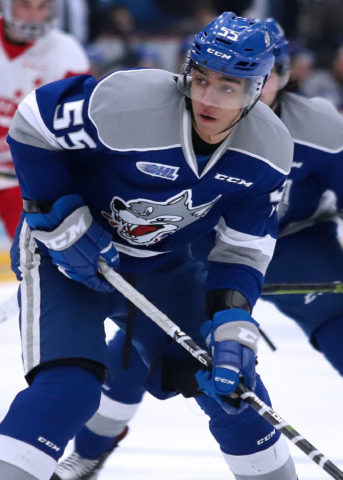Eric Lindros.
That has been the tagline to describe Quinton Byfield recently. While this comparison may be a bit exaggerated and unfair, it does display how high many believe his ceiling can be. His physical appearance alone is very intriguing. There are not many strong skating 6-foot-5, 215 pounds, 17-year-old centers in the hockey world, let alone those that possess the amount of sheer skill he does.
Drafted first overall in the 2018 Ontario Hockey League (OHL) Priority Draft, Byfield produced just shy of a point-per-game in his rookie season for the Sudbury Wolves. He was then an integral part of the team making the second round of the OHL playoffs for the first time since 2013. This summer he played for the Canadian Hlinka-Gretzky Cup team, recording five points in five games on route to a silver medal.
The top prospect has gotten off to a hot start this OHL season, with 12 points in 5 games. Byfield looks much more confident and has an increased potential to take over a game at any time. He is also learning that he is able to be more selfish with the puck, not passing to a teammate every opportunity he gets.

Strengths
Playmaking
Byfield is an excellent passer. He anticipates the play seemingly before everyone else on the ice. The Wolves’ star sees the ice exceptionally well and finds his teammates with ease (not just because he can look over everyone). He creates space for himself and his linemates by waiting for the perfect time to make a play in the offensive zone.
Puck Possession
In today’s analytical NHL, puck possession is everything. This is good news for Byfield because he is fantastic at it. Using his big frame, he excels at preventing turnovers with his long reach and puck skills. The top prospect is a dangerous presence anytime he has the puck because of this attribute, as shown in this clip.
Skating
Despite being 6-foot-5, Byfield is one of the best skaters in his draft class. He may not have the fastest breakaway speed, but he uses it effectively. His acceleration and edge-work is terrific. He can turn on a dime, creating a gap between him and his opponent when doing so. This is also why he is such a great puck protector.
Weaknesses/Areas of Improvement
Aggressiveness
A theme in this article is Byfield’s size. While that alone is valuable (especially in junior), the 17-year-old has not grasped how to use his build to his advantage in puck battles and in the defensive zone. This is the most significant part of Lindros’ game that Byfield does not exhibit. Although the center has already seemed to improve this part of his play in the early stages of this season, it will be interesting to see if this area continues to develop.
Defensive Zone Awareness
This part of a teen phenom’s talents usually falls behind the rest of his game. Byfield has proved consistent with this theory. His lack of aggressiveness also relates to his defensive game. The forward needs to use his large build and reach to break up plays and his long stride to turn the puck around quickly, which can develop into increased scoring chances. Improving his defensive game can, in turn, make him a better offensive player.
Offensive Zone Decision Making
In his rookie season, Byfield had the tendency to pass the puck too often, at times when the better option was to shoot. The Wolves’ forward would benefit from trusting his shot more frequently. He tends to try to find the perfect play and can ruin a scoring chance in the process. Improving this aspect of the prospect’s game will just make him even more of a scoring threat than he already is.

Season Projection
Quinton Byfield has set himself up to have a monster season in the OHL. Playing with quality linemates for the Wolves, it is not a stretch that the teenager could lead the league in points by the end of the year. His play could also lead him to an opportunity playing for Canada at the World Juniors. Byfield is a top-notch prospect for the upcoming NHL draft and is currently projected to be picked as high as top-two. Everyone should be excited to watch what he has in store for us this season.